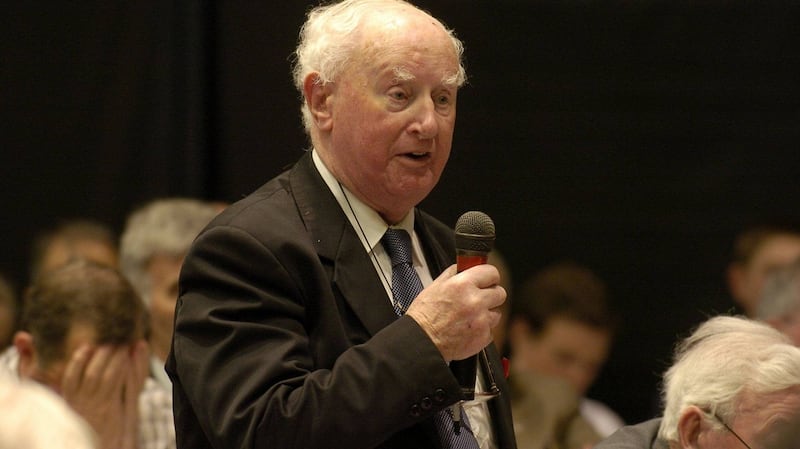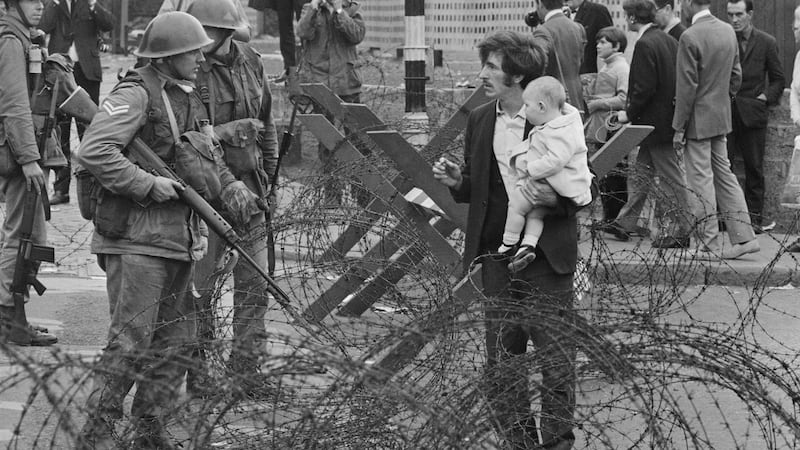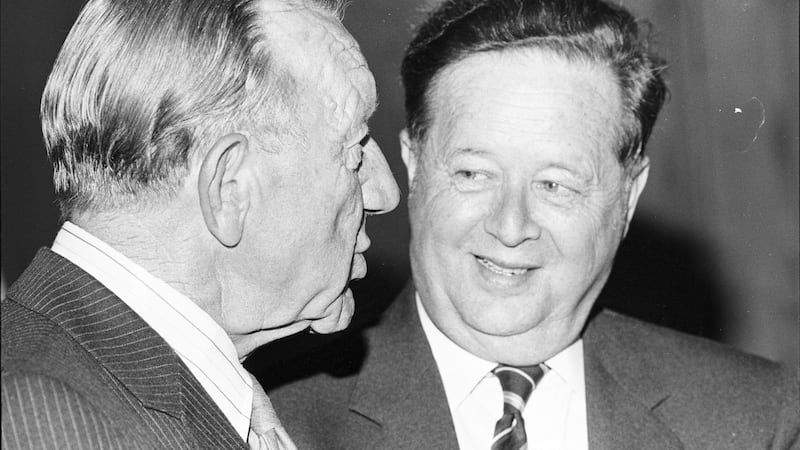If all that 1971 did was to abolish the old Rule 27 – the Ban on foreign games – it would still qualify as one of the most important years in the GAA’s history. Yet, what followed after that Easter was a succession of events that set a course for the association that it is in some cases still tracking.
There's no denying the impact of the congress vote, though. On Saturday April 10th, 1971 in QUB's Whitla Hall, the association ditched the prohibition and triggered a decades-long process of divesting itself of exclusionary rules.
"Today, the 86th annual assembly of GAA legislators opens in Queen's University, Belfast, " ran Paddy Downey's preview on these pages, "and it is fair to say that this meeting, which continues tomorrow, will be the most momentous in the long and chequered history of the great organisation."
That there is any sense of drama absent is a simple reflection that the matter was already concluded.
The rule’s fall that year was predestined in that all counties had conducted a plebiscite to ascertain the views of members – the result of a Trojan horse motion in 1968 to look into the justification for the Ban – and by the weekend of congress, it was all over before a vote was cast on Motion 1.
Only Antrim and Sligo – surprisingly, as they had previously been reformers on the issue – had opposed.
At the end of the year, there was a litany of landmark events. Never mind, ‘years that matter’ were there to be a review of ‘months that matter’ December 1971 would be up there with November 1884.
Firstly, the Commission on the GAA, chaired by former president Pádraig MacNamee, reported after nearly two years of deliberations, having been set up by the congress of 1969 as the first major review of association activities and structures.
November saw the first official All-Ireland club final won by the footballers of East Kerry, who beat Bryansford from Down. A month later, Roscrea won the hurling against Offaly's St Rynagh's.
Days previously that December the first All Star awards were presented in Dublin’s Intercontinental Hotel (later Jurys).
But back to April for a moment.
The abolition of the Ban was a cumulative process and not just because of rolling series of votes around the country that sealed its fate but rather in the way it gathered momentum throughout the 1960s even though its failure to achieve one third of the delegates’ votes in 1962, ’65 or ’68 confined its consideration to intervals of three years.
Ireland and the GAA changed in the 1960s and a key influence on sporting tastes is accepted as being the 1966 World Cup, held in England and which was seen widely on Irish television as RTÉ broadcast highlights.
The little noticed Mayo motion in 1968 to commission a report into the reasons for holding on to the Ban culminated in another motion in 1970 tabled by Meath to the effect that ordinary members should be allowed vote on the matter before it came to congress the following year.
At the turn of 1970 and early ’71, the news coming out of county conventions all around the country was clear. Rule 27 was doomed. Thirty counties – plus four British delegations – voted for abolition.
In Monaghan, a delegate topically described the Ban as “Paisleyism in reverse”.

Reform created difficulty for older members and officials. Then president Pat Fanning was a firm supporter of the rule but had to accept that the game was up and he was praised for the equanimity with which he accepted this reverse.
His annual address to congress was nonetheless plangent on the question of what the GAA stood for and being essentially forced into compromise with the modern world.
“In a short while now, you will acknowledge the expressed will of the association and delete a rule, which for many of us was a rule of life and reflected and epitomised the very spirit of the association. The rule deleted – what then? Do we then reject the past and with deletion, proclaim ourselves a mere sports organisation?”
There were two sidebars in all of this. Also proposed was the deletion of Rule 26 – in later Official Guides to become Rule 21 – or the prohibition on members of the Northern security forces joining the GAA.
That too had been put to the wider membership but by the end of January when emerging votes had rendered the Ban a beaten docket, there had hardly been a majority let alone two-thirds of the membership in favour of relaxing the bar on the British army and Northern police.

The motion would be withdrawn and in his speech, Fanning described the very prospect of it succeeding as “a rejection of the very basis of GAA national thinking”.
The elephant in the room at the 1971 congress, especially as it was being held in Belfast, was the complete absence of any reference to the Troubles. Remember this was just four months before internment was introduced and 10 months before Derry’s Bloody Sunday.
The baleful influence of those unfolding events meant that abolition of that rule would take another 30 years.
The second sidebar concerns the old Rule 42, the prohibition on other sports being played in GAA grounds. Strangely it didn’t exist in 1971 but was the result of the report from a group set up by Fanning to shore up traditional thinking in the association in the wake of the Ban’s deletion.
His own views indicated what was coming.
“Are our clubs, their roots deep in parish, town and city to cease to be GAA units as our fathers moulded them? Is it possible our Gaelic fields, purchased and developed with GAA money so that Irish boys should play Irish games, may be used for other purposes to weaken and perhaps ultimately destroy the association?”
That prohibition when it arrived would last until the 2005 opening of Croke Park to rugby and soccer internationals and was only fully ditched in 2019, in the wake of the Liam Miller tribute match in Cork, nearly 50 years later.
It is worth also reflecting on other aspects of Pat Fanning’s address in 1971, as it was in some respects quite prophetic. He referred to exhibition matches between the All-Ireland champions Kerry and an “all-star team drawn from several of our counties” that had taken place in 1970 and said that such events “were capable of becoming a permanent feature of the GAA year”.
In December the first official All Stars selections were announced. A journalists' awards scheme that owed much to the late Mick Dunne, who modelled it on American sports, it became part of the association's calendar and may this year if possible to proceed, celebrate its 50th iteration.
The All Stars and the All-Ireland club finals, which debuted within a few days of each other in December 1971, have done a lot to recognise players who have no realistic chance of winning senior All-Irelands and have provided both an honours system and a meaningful, national competitive outlet, albeit more in football than hurling.
At the beginning of that month, the Report of the Commission on the GAA had been published.
Its recommendations make interesting reading. Some were implemented and have lost any ground-breaking resonance they might once have had – the decision to accept sponsorship and advertising at Croke Park – and some were quietly forgotten about but taken together, they represent a snapshot of attitudes and concerns as the GAA headed into what might loosely be termed ‘the modern age’.
It was decided that the then general secretary should be re-designated the director general and that a full-time public relations officer should be appointed. At the time the total staff at Croke Park numbered eight.
There were recommendations for a national hurling coaching officer as well for a standing committee on the rules of football. The Management Committee that today runs the GAA during the pandemic emergency, was the brainchild of the Commission.

The protocol adopted saw the 1972 congress accept the report in principle and leave it to the new Management Committee to implement the individual reforms. As a result a number of reforms never saw the light of day.
Yet many did and the report eventually gained the validation of history. Retiring DG, Seán Ó Síocháin, in his farewell address to congress in 1979 paid tribute to the impact of the commission’s proposals:
“The MacNamee Commission had crystallised much of the new thinking in the association, pointed to horizons hitherto undreamt of and got the whole organisation to think and act in a bigger, better, more positive and more professional way than it had ever done before.”
In the current time of arguably unprecedented challenge for the GAA, perhaps the most defiant message to take from this remarkable year nearly half a century past, comes from the conclusion to Pat Fanning’s annual address in Belfast.
“The future is ours to shape. Let’s move towards it with confidence.”






















